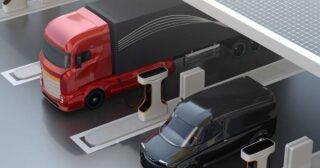- Resources
- Charging ahead: Key reasons for confidence in a commercial EV trucking future
Resources
Charging ahead: Key reasons for confidence in a commercial EV trucking future
Published: October 3, 2024 by Maaz Haider
As the world grapples with the increasing frequency and intensity of natural disasters, the impacts of climate change have become a tangible concern for millions of people. Among the largest contributors to this crisis is transportation, the largest source of U.S. emissions, and medium- and heavy-duty vehicles have an outsized impact.
Hence, reducing transportation emissions is essential. Transitioning to zero-emission trucks will slash climate and air pollution everywhere, improve local economies by creating new jobs, strengthen national security by reducing our dependence on imported oil, and save fleets money on fuel – all of which are especially critical now.
While uncertainties remain about the ultimate pace of scaling zero-emission medium- & heavy-duty vehicles, this presents an opportunity for innovative partnerships. By working together to address challenges, we can accelerate the transition to zero-emission trucks and reinforce the transportation sector’s commitment to a sustainable future.
Infrastructure improvements: The backbone of EV success
The industry has made significant strides in developing charging infrastructure to support electric trucks. Private investment, as well as support from government programs, is beginning to address the infrastructure challenge.
Fueled by public and private funds, there are now around 183,000 public charging ports in operation within the U.S. as of Q2 2024–well on target to meet Biden’s administration goal of half a million public ports by 2030.
The funds allocated under the Bi-Partisan Infrastructure Law through the National Electric Vehicle Infrastructure (NEVI) program and the Charging & Fueling Infrastructure (CFI) Discretionary Grants program are actively being awarded and implemented. Three charging sites in New York, Ohio, and Pennsylvania are already operational under NEVI, with 47 additional projects announced under CFI, which will deploy over 5,000 Level 2 chargers and more than 600 Level 3 fast chargers.
Efforts led by other private groups solidify the future of public charging in the country. Notably, Forum Mobility will be deploying 1,000 DC fast chargers in California. Furthermore, Greenlane, a partnership between Daimler, NextEra Energy, and BlackRock, to develop a nationwide network of high-performance charging stations starting with a 280-mile corridor between Los Angeles and Las Vegas. Recently, a group of carriers and shippers, which includes AIT Worldwide, DB Schenker, Maersk, Microsoft, PepsiCo, and others, have formed a coalition to pilot heavy-duty charging with Terawatt Infrastructure along the I-10 corridor.
Technological advancements: Breaking the range barrier and demonstrating reliability and performance
Advancements in battery technology continue to improve the capacity of electric trucks, including adding range and reducing charging times.
Legacy manufacturers like Daimler and Freightliner, along with new entrants such as Nikola, Tesla, and Windrose, are leading the charge in electric truck innovation, offering impressive ranges on a single charge.
Tesla’s Semi truck promises a range of up to 500 miles with PepsiCo, one of the early adopters of the Semi, having successfully integrated these trucks into its fleet for regional distribution. Real-world data from Pepsi’s deployment has successfully accomplished a 1000+ mile journey in a single day. Further data revealed by NFI which also piloted the Tesla Semi’s reveals impressive efficiency statistics surpassing performance expectations and highlighting the vehicle’s long-range capabilities.
Another new entrant in the market is Windrose with their EV trucks offering upwards of a 400-mile range at full load. As per the Zero-Emissions Technology Inventory (ZETI) tool there are currently 21 different OEMs (Original Equipment Manufacturers) offering 24 different EV van and truck models with a range of 200+ miles.
Financial incentives and operational savings: The economic argument
While the sticker price of electric trucks is higher compared to traditional diesel trucks, as per BloombergNEF’s New Energy Outlook 2024, due to battery cost reduction and efficiency improvements, zero-emission trucks’ cost parity can be reached even sooner with the urban duty cycle becoming cost competitive before 2030.
Furthermore, subsidies and tax breaks under the Inflation Reduction Act and public grants can help offset the upfront capital costs.
Specifically, IRA provision 45W allows fleets to reduce the cost of an electric truck by up to $40,000, while provision 30C enables savings of up to 30% on the cost of installing charging infrastructure. Moreover, the total cost of ownership (TCO) savings outlook for electric trucks is further amplified due to savings on fuel and maintenance.
Titan Freight Systems demonstrated these cost savings for medium-duty and heavy-duty trucks in a presentation at the ACT Expo 2024 showcasing 10% and 7% savings in these applications respectively. The savings will increase as more EVs are deployed since the cost of existing charging infrastructure will be spread across a larger fleet
Make like bamboo: From laying the groundwork to rapid growth and advancement
The growth of EVs and charging infrastructure in the U.S. can be likened to the growth of a bamboo shoot. After years growing deep roots with little visible growth above ground, bamboo suddenly shoots up rapidly, symbolizing how foundational work leads to swift, visible progress.
Similarly, the EV industry initially experienced slow adoption, focused on building the necessary technology, regulatory frameworks and consumer awareness. However, with these strong foundations now in place, thanks to policies like the Inflation Reduction Act, NEVI, and other initiatives, the industry is experiencing rapid growth, much like bamboo’s sudden upward shoot. According to the EDF Electric Fleet Deployment & Commitment tracking tool commercial EV deployments grew 5 times with more than 10,000 Class 2b-8 EVs deployed in 2023 followed by more than 15,000 EVs deployed year to date in 2024.
The EV industry’s steady groundwork is enabling companies in the U.S. to quickly expand their EV truck fleets, making significant strides toward sustainable transportation.

